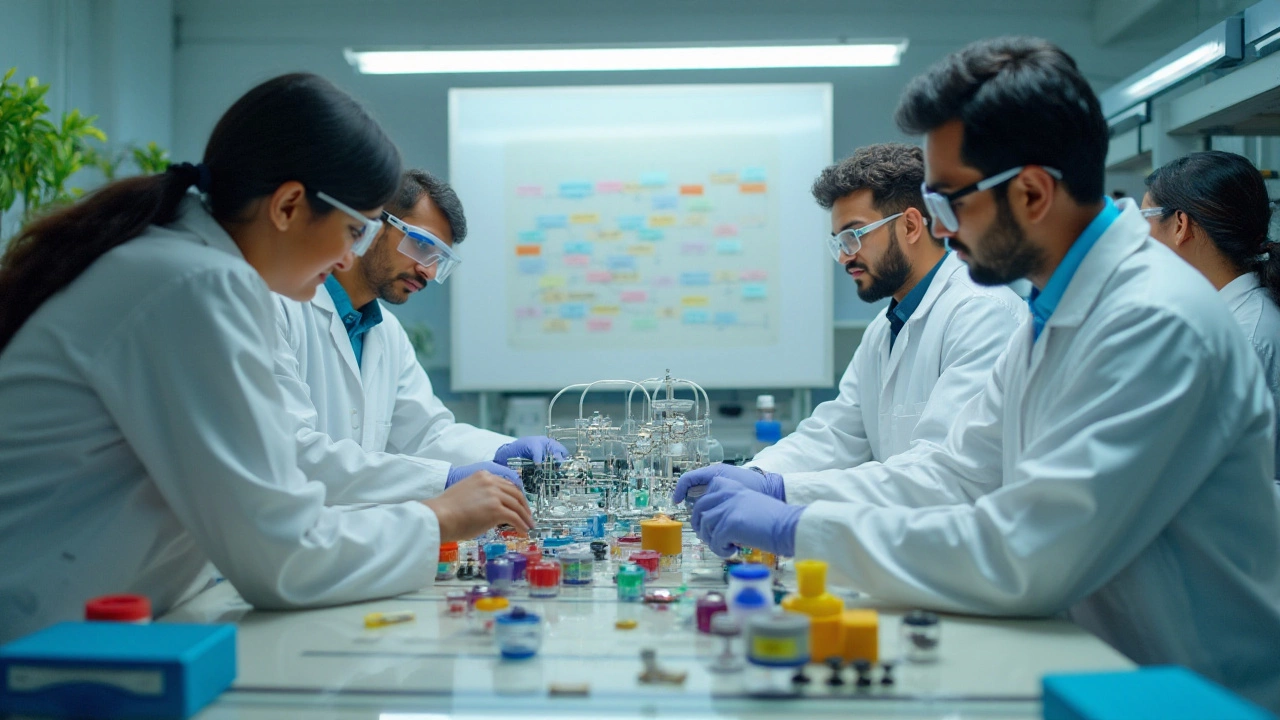Mastering the 4 C's of Effective Teamwork for Scientific Collaboration
 Jan, 21 2025
Jan, 21 2025
When it comes to advancing scientific endeavors, teamwork is not just beneficial; it's essential. The secret to success lies in mastering the four C's—Communication, Cooperation, Coordination, and Commitment. Each of these components plays a vital role in ensuring that scientific collaboration is as smooth and productive as possible.
Imagine a world where discoveries are stunted not by lack of knowledge, but by poor teamwork. By integrating these core principles, teams can break barriers and create groundbreaking solutions that might otherwise remain out of reach.
The Power of Communication
Communication is often touted as the cornerstone of successful teamwork, especially in the realm of scientific collaboration. It is the essential thread that weaves individual efforts into a cohesive tapestry of shared understanding and mutual progress. By fostering an environment where ideas can be freely exchanged, communication helps in breaking down silos that often exist in organizational structures. In the scientific community, this openness is crucial. When team members are encouraged to speak up about their findings or raise challenges, solutions tend to emerge not as lone sparks but as collective insights stitched together from diverse perspectives.
Effective communication involves more than just exchanging information. It's about understanding the emotion and intentions behind the information. For scientists, clear expectations and active listening can be the difference between groundbreaking research and prolonged uncertainty. Teams that prioritize communication often see increased motivation and efficiency. This process is not just about making someone aware of something but also about ensuring that there is a mutual understanding and that actions align with words. A compelling demonstration of communication's power can be seen in the Human Genome Project, a massive scientific effort where multinational teams worked seamlessly together, transcending geographical and cultural boundaries.
"The art of communication is the language of leadership." - James Humes
An often-cited example of excellence in communication is NASA's mission control teams during the Apollo missions. The intricate dance of signals, data, and decisions made, minute by minute, illustrates how communication can determine the very success of a mission. In scientific settings, similar practices can translate into protocols where clarity, conciseness, and context are the guiding principles. Structured meetings and use of visual aids such as charts or diagrams can further enhance understanding, allowing complex ideas to be transmitted more effectively. Frequent check-ins and feedback loops provide team members with a sense of shared responsibility and involvement, driving them toward common objectives with clarity and purpose.
While technology offers tools like emails, video conferencing, and collaborative platforms to bridge the communication gap, the human element—listening, empathy, and encouragement—remains irreplaceable. The promise of effective communication in scientific teamwork is that it can bolster the feeling of belongingness and shared vision among team members, significantly amplifying their commitment to the collective goals. Without robust communication strategies, misinterpretations and mistrust can easily arise, causing rifts that ultimately hinder progress.
In essence, communication in scientific collaborations is not just a skill but a strategic tool that, if wielded effectively, can drive a team's ultimate success. Recognizing this power and actively seeking to improve communication strategies within teams positions projects to not only avoid pitfalls but to also excel beyond anticipated horizons. So, the ability to convey, listen, and respond aptly is not merely complementary to scientific success but integral to it.

Fostering Cooperation
In the realm of scientific teamwork, the concept of cooperation cannot be overstated. It serves as the backbone of all collaborative endeavors, allowing diverse talents to coalesce around a common purpose. To foster this cooperative spirit, a foundation of mutual respect and understanding must be established. This means recognizing and valuing each team member’s unique contributions, experiences, and perspectives. When individuals feel respected and valued, they are more inclined to freely share their insights and resources, which can lead to innovative breakthroughs.
One effective way to nurture cooperation is by establishing common goals that resonate with the entire team. Having clear, articulated objectives ensures that everyone is on the same page, providing direction and purpose. These goals should be specific, measurable, and attainable, so each team member can understand their role in achieving them and how their contributions fit into the bigger picture. Studies show that teams with well-defined goals are much more likely to succeed in their missions, as they can navigate challenges with a shared sense of purpose.
Another crucial aspect of cooperation is effective conflict resolution. Disagreements are inevitable in a collaborative environment, especially when passionate individuals are involved. However, these conflicts can be handled constructively if approached from a place of empathy and open-mindedness. Encouraging an atmosphere where differences are discussed openly and solutions are sought collectively strengthens the team. Conflict, when managed well, often leads to deeper understanding and more cohesive units, transforming potential roadblocks into opportunities for growth.
Building trust within the team is paramount to fostering cooperation. Trust doesn’t develop overnight, but rather through consistent, positive interactions. Team-building activities can play a significant role in accelerating this process. Additionally, transparent communication and reliability are essential components in cultivating trust. When team members know they can rely on each other to follow through on commitments and share relevant information, they are more likely to engage cooperatively, resulting in a more dynamic and innovative team environment.
According to a report by the Harvard Business Review, cooperative efforts in research projects are linked to higher levels of creativity and problem-solving abilities. Moreover, teams that frequently engage in cooperative tasks often exhibit better morale, which in turn enhances their productivity and impact. The power of cooperation is evident in numerous successful scientific collaborations around the world, where diverse minds unite to tackle humanity’s most pressing challenges.
“Coming together is a beginning, staying together is progress, and working together is success.” - Henry Ford
The journey to foster cooperation requires dedication, patience, and a relentless focus on cultivating a collaborative atmosphere. By maintaining a culture that values each contribution, seeks collective success, and embraces diversity, teams can truly unlock their potential and push the boundaries of what is scientifically achievable.

Harnessing Coordination
Collaboration without effective coordination often results in brilliant ideas lost in chaos. In the realm of scientific collaboration, coordination is the glue that binds individual endeavors into a cohesive force of innovation. Imagine a research team where every member is diligently working within their own niche but lacks the synchronization needed for impactful outputs. Here, coordination plays the role of a conductor in an orchestra, ensuring that each element aligns perfectly with the others to create a harmonious symphony of progress. A well-coordinated team can allocate resources efficiently, prevent unnecessary duplication of efforts, and ensure seamless integration of shared activities. This synergy not only simplifies complex tasks but also accelerates the pace of discovery.
Building a Framework for Success
To effectively harness coordination, one must first establish a clear framework. This framework acts as a blueprint guiding the team through their collaborative journey. It involves identifying key objectives, roles, and responsibilities across the team. A structured framework ensures that everyone knows what needs to be done, who is responsible, and the timelines involved. Digital tools and platforms can be powerful allies here, allowing for the visualization and tracking of project progress. Such platforms can offer real-time updates on task completions, identify bottlenecks, and ensure that everyone is on the same page. Embracing technology is a game-changer, facilitating seamless exchanges of information across diverse geographical locations.
Real-Life Benefits of Coordination
The advantages of strong coordination are best illustrated by successful scientific initiatives. For instance, the Human Genome Project, a landmark collaborative effort, demonstrates how coordination can propel a project to extraordinary heights. It's fascinating how this project, which involved scientists from various parts of the world, managed to map the entire human genome years ahead of schedule due to meticulous coordination. By setting clear milestones and using specialized management systems, the project significantly reduced time and costs. This example emphasizes the value of coordination in transforming ambitious goals into reality. Without these well-coordinated efforts, achieving such groundbreaking outcomes would have been far less feasible.
"Coming together is a beginning, staying together is progress, and working together is success." - Henry Ford
Coordination doesn't happen overnight; it requires consistent effort and adaptation. It involves regular check-ins and constructive feedback loops, creating a culture of openness and adaptability. A setting where team members feel empowered to voice challenges and offer solutions nurtures growth. Communication interwoven with coordination keeps all participants connected, fostering a unified vision among them. Together, these efforts cement a foundation from which impactful scientific advancements can be launched.

Embracing Commitment
Commitment in teamwork is the driving force that moves a team from intention to action. In scientific collaboration, this steadfast dedication ensures that all team members align with the shared vision, driving the collective efforts forward. Commitment is more than just showing up; it encompasses an intrinsic motivation to pursue the overarching goals, even when challenges arise. Dedication among team members boosts morale, fosters accountability, and strengthens the resolve to see projects through to completion. Did you know that a committed team is often twice as likely to reach their objectives efficiently compared to those where commitment is lacking? This is because, in committed teams, every member takes ownership of their contributions and strives to shoulder the collective task, understanding deeply how their roles intertwine with the ambitions of others.
In practice, embracing commitment requires creating a culture that values and recognizes individual and collective efforts. Encouragement, both formal and informal, plays a crucial role in maintaining motivation levels high. Celebrating small wins within the project can keep the energy and enthusiasm alive. It's essential to set clear expectations and provide each member with a sense of purpose that ties into the team's mission. Successful scientific collaborations, such as those seen in the remarkable project of mapping the human genome, are testaments to how profound dedication to a common goal can lead to extraordinary achievements. The Human Genome Project wasn’t just about decoding DNA; it was about uniting thousands globally under a single, ambitious mission. A renowned scientist once remarked,
"Commitment is the bedrock of scientific innovation. Without it, breakthrough possibilities remain distant dreams."His words echo the sentiment that dedication turns potential into reality.
Research indicates that commitment has a direct correlation with a project's success metrics. A study found that highly committed teams have a completion rate in scientific endeavors nearly 12% higher than those with wavering resolve. Such statistics underline the pivotal role that fully embracing commitment plays. It is, therefore, imperative for leaders and project managers to cultivate this quality within their teams. They should foster open communication channels to address concerns, regularly revisit goals to ensure they remain relevant, and prioritize personal development alongside project milestones. This approach not only builds a strong bond among collaborators but also lays the foundation for sustainable and rewarding scientific endeavors.